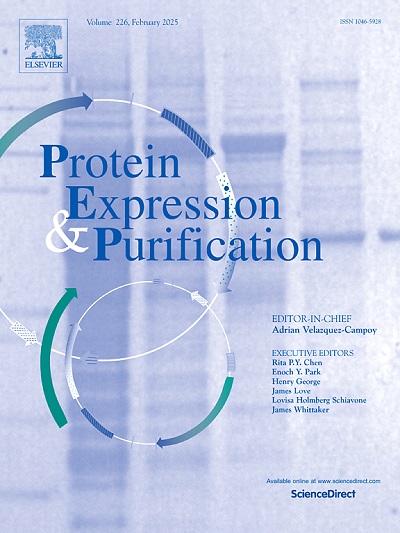Column-free purification of functional HIV-1 capsid protein and its application in assembly and inhibitor assays
IF 1.2
4区 生物学
Q4 BIOCHEMICAL RESEARCH METHODS
引用次数: 0
Abstract
The HIV-1 capsid protein (CA) is essential for viral replication and serves as a validated antiviral drug target. Traditional purification of CA relies on multi-step chromatographic protocols, which are time-consuming and labor-intensive. In this study, we established a rapid, column-free purification strategy using a cleavable self-aggregating tag (cSAT) to produce functional wild-type CA protein from E. coli with >95 % purity within a single day. The workflow is compatible with high-throughput formats and scalable from microplates to fermenters, offering significant advantages over conventional purification methods. The purified CA retained full biological activity, as demonstrated by its ability to assemble into higher-order structures in a salt- and protein concentration–dependent manner in vitro. We further evaluated the effects of two well-characterized capsid modulators: CAI, a peptide inhibitor, and lenacapavir (LEN), a clinically approved capsid-targeting drug. Turbidity-based assembly assays confirmed that CAI inhibited and LEN enhanced CA assembly in a dose-dependent manner. When co-administered, CAI and LEN exhibited mutually antagonistic effects. Preincubation with CAI abolished LEN-mediated enhancement, indicating a potential conformational lock imposed by CAI. These findings demonstrate that the column-free strategy enables efficient production of functionally active CA protein suitable for downstream biochemical and inhibitor screening assays. The approach provides a practical tool for accelerating HIV-1 capsid research and antiviral discovery.
功能性HIV-1衣壳蛋白的无柱纯化及其在组装和抑制剂检测中的应用
HIV-1衣壳蛋白(CA)对病毒复制至关重要,是一种有效的抗病毒药物靶点。传统的CA纯化依赖于多步骤色谱协议,耗时费力。在这项研究中,我们建立了一种快速的无柱纯化策略,使用可切割自聚集标签(cSAT)在一天内从大肠杆菌中获得95%纯度的功能性野生型CA蛋白。该工作流程与高通量格式兼容,可从微孔板扩展到发酵罐,与传统纯化方法相比具有显着优势。纯化后的CA保留了充分的生物活性,这证明了它在体外以盐和蛋白质浓度依赖的方式组装成高阶结构的能力。我们进一步评估了两种表征良好的衣壳调节剂的作用:肽抑制剂CAI和临床批准的衣壳靶向药物lenacapavir (LEN)。基于浊度的组装试验证实CAI以剂量依赖的方式抑制和LEN增强CA组装。同时给药时,CAI和LEN表现出相互拮抗作用。CAI的预培养消除了len介导的增强,表明CAI施加了潜在的构象锁。这些发现表明,无柱策略可以有效地生产功能活跃的CA蛋白,适用于下游生化和抑制剂筛选试验。该方法为加速HIV-1衣壳研究和抗病毒药物的发现提供了实用的工具。
本文章由计算机程序翻译,如有差异,请以英文原文为准。
求助全文
约1分钟内获得全文
求助全文
来源期刊

Protein expression and purification
生物-生化研究方法
CiteScore
3.70
自引率
6.20%
发文量
120
审稿时长
32 days
期刊介绍:
Protein Expression and Purification is an international journal providing a forum for the dissemination of new information on protein expression, extraction, purification, characterization, and/or applications using conventional biochemical and/or modern molecular biological approaches and methods, which are of broad interest to the field. The journal does not typically publish repetitive examples of protein expression and purification involving standard, well-established, methods. However, exceptions might include studies on important and/or difficult to express and/or purify proteins and/or studies that include extensive protein characterization, which provide new, previously unpublished information.
 求助内容:
求助内容: 应助结果提醒方式:
应助结果提醒方式:


